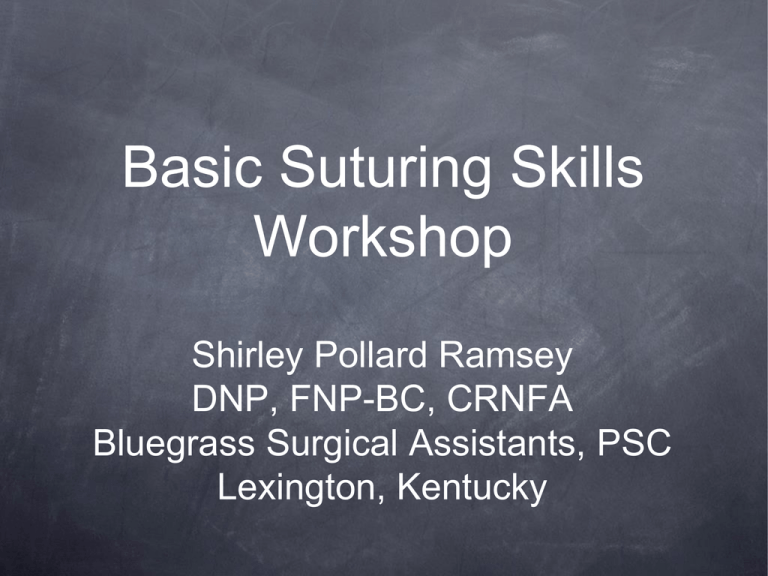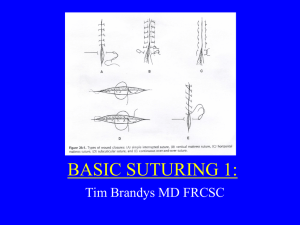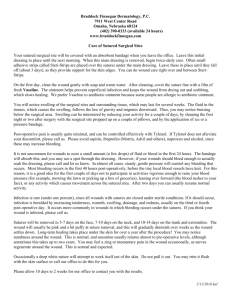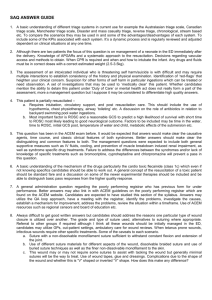Basic Suturing Skills Workshop
advertisement

Basic Suturing Skills Workshop Shirley Pollard Ramsey DNP, FNP-BC, CRNFA Bluegrass Surgical Assistants, PSC Lexington, Kentucky Ideally wound closure should be effective: simple, efficient, inexpensive, and painless, and should achieve optimal cosmetic results. OBJECTIVES Review the Anatomy and Physiology of the Wound Healing Process Discuss the Guidelines for Seeking Surgical Consultation for Laceration Repair Assess, Inspect and Evaluate the Patient and Wound Outline Commonly used Anesthetic Agents, including Pharmacology, onset of action, and duration of action. Demonstrate administration of local anesthesia for wounds including digit and toe blocks. Identify the various types and sizes of suture material. Review and demonstrate basic wound closure techniques including skin lines Develop a wound care plan and follow-up for suture removal. Demonstration and Discussion ANATOMY / SKIN and FASCIA Epidermis Dermis Superficial Fascia Deep Fascia THE WOUND HEALING PROCESS The entire wound healing process is a complex series of events that begins at the moment of injury and can continue for months to years. The wound healing process includes: I. Hemostasis II. Inflammatory (preparative) Phase III. Proliferative Phase (Collagen formation) IV. Tissue Remodeling (Resolution)Phase I. Hemostasis Vascular constriction Platelet aggregation, degranulation, and fibrin formation (thrombus) Healing II. Inflammatory Phase Inflammation, Vasodilation, Phagocytosis Neutrophil infiltration Monocyte infiltration and differentiation to macrophage Lymphocyte infiltration Process: 3-7 days III. Proliferative Phase Re-epitheliazation Angiogenesis Collagen synthesis Extracellular matrix formation IV. Remodeling Phase A) 3 weeks to 2 years B) New collagen forms which increases tensile strength to wounds C) Scar tissue is only 80 percent as strong as original tissue Collagen remodeling Vascular maturation and regression Guidelines for Seeking Surgical Consultation for Laceration Repair Deep wounds of the hand or foot Full-thickness lacerations of the eyelid, lip, or ear Lacerations involving nerves, arteries, bones, or joints Penetrating wounds of unknown depth Severe crush injuries Severely contaminated wounds requiring drainage Wounds leading to a strong concern about cosmetic outcome ASSESS / EVALUATE / PLAN WOUND MANAGEMENT Note: Bleeding / Control by direct pressure History Mechanism of injury Age of wound Personal Health History Age, human immunodeficiency virus and diabetes status, oxygenation, tobacco use, alcoholism, nutrition, radiation tetanus immunization history ALLERGIES to: latex, local anesthesia, tape, or antibiotic Associated signs and symptoms ASSESS / EVALUATE / PLAN WOUND MANAGEMENT (cont’d) Time of incident Location Level of Bleeding Baseline neurovascular and functional status of the involved body part Involvement of tendons, nerves, blood vessels, or bone involvement should be evaluated before repair Size and Depth of wound Shape Foreign bodies Contamination Contradictions to Wound Closure Redness around edges Infection Fever Edema-excessive Puncture Wounds Animal Bites ( MUST BE REPORTED) Wounds with nerve or tendon damage Wounds of eye, eye lid, bites (Human & Animal) are very contaminated Wounds of the thoracic or abdominal cavities Wound greater than 12 hours REVIEW Anesthetic Agents and Correct Dosages for the Different Suture Sites Lidocaine (with or without Epinephrine) Most commonly used, Rapid Onset Strength 0.5%,1%,2% Max Dose 5mg/kg * Can use with Epinephrine for prolonged effect and decreased bleeding. Dosage is 7mg/kg. DO NOT USE EPINEPHRINE on Eyes, Nose, Fingers, Toes, Penis, Scrotum, or Ears. Marcaine (with or without epinephrine) Slow onset, long duration Max Dosage 3mg/kg 0.5% and 1% Agent Lidocaine 1%, 2% (Xylocaine) Lidocaine 1%, 2% with Epinephrine (Xylocaine) Mepivacaine (Carbocaine) Bupivicaine (Marcaine or Sensorcaine) Topical Agents LET Infiltration Block in Minutes Duration of Action Maximum allowable for single dose Immediate 4-10 minutes 30 -120 minutes 1%:4.5 mg/kg (30 mls in avg adult) Immediate 4-10 minutes 60-240 minutes 7 mg/kg 6-10 1% - 2% Immediate minutes 90 - 180 minutes 5 mg/kg 240-480 minutes 3 mg/kg 20-30 minutes 2-5 mls Concentration 1% - 2% 1% 0.25%0.5% slower 5-15 minutes 8-12 INJECTION TECHNIQUES *** CHECK for ALLERGIES! (True allergies are uncommon, but do occur.) In persons who are allergic to amides use: 1 ml dyphenhydramine (50 mg/ml) to 4 ml sterile saline for local anesthetic effects Use 25 gauge needle or smaller to decrease sting of injection Insert needle at inner edge of wound Aspirate Inject anesthetic as you pull the needle out Buffering with 1 ml of 8.4% sodium bicarbonate (1 ml / 10 ml local anesthetic) to 10 ml of local anesthetic significantly reduces pain of injection DIRECT WOUND INFILTRATION DIGITAL BLOCK TOE BLOCK IDENTIFY the various types and sizes of suture material Absorbable vs. non-absorbable Natural vs. synthetic Monofilament vs. multifilament ABSORBABLE SUTURE Degraded and eventually eliminated in one of two ways: Inflammatory reaction utilizing tissue enzymes Hydrolysis Examples: “Catgut” (Untreated Chromic) :Very fragile and non reactive Chromic ( Catgut treated with chromium salt solution to aid in resisting breakdown): Absorption is 90 days, TSR: 28 days Vicryl (Polyglactin): TSR: 75% at 2 weeks, 50% at 3 weeks, 25% at 4 weeks Monocryl: High tensile strength in the first few weeks. TSR: 60 - 70% at 1 week, 30 - 40% at 2 weeks PDS: Longest retention of the absorbable sutures. 70% at 2 weeks. 50% at 4 weeks. 25% at 6 weeks NON-ABSORBABLE Not degraded, permanent Examples: Prolene: Does not adhere to tissue (Blepharoplasties) Nylon: Skin closures Stainless steel: Now used primarily in sternal closures Silk* Poor tensile strength if wet (*not a truly permanent material; known to be broken down over a prolonged period of time—years (1 year plus) NATURAL SUTURE Biological origin Cause intense inflammatory reaction Examples: “Catgut” – purified collagen fibers from intestine of healthy sheep or cows Chromic – coated “catgut”: facial wounds, lip/intraoral mucosa, children’s wounds. Lasts 7-14 days at most. Silk SYNTHETIC SUTURE Synthetic polymers Do not cause intense inflammatory reaction Examples: Vicryl / SH Monocryl / SH / PS-2 PDS Prolene Nylon FS-2 MONOFILAMENT SUTURE Grossly appears as single strand of suture material; all fibers run parallel Minimal tissue trauma Resists harboring microorganisms Ties smoothly Requires more knots than multifilament suture Possesses memory Examples: Monocryl, PDS, Prolene, Nylon MULTIFILAMENT SUTURE Fibers are twisted or braided together Greater resistance in tissue Provides good handling and ease of tying Fewer knots required Examples: Vicryl (braided) Chromic (twisted) Silk (braided) Suture Materials Material Vicryl Monocryl Structure Braided / Absorbable Monofilament / Absorbable Chromic Braided / Absorbable Nylon Monofilament / NonAbsorbable Prolene Monofilament / NonAbsorbable Tissue Reaction Tensile Strength Knot Security Advantages Minimal High 75% at 2 weeks50% at 3 weeks(6-0 and larger) Hydrolysed in 56-70 days Good Easy to handle, but has increased potential for infection Minimal High 50-60% at 1 week (undyed) 60-70% (dyed)Lost by 28 days Good Easy to handle Moderate Low Lasts 7-14 days at most. Good Chromic – coated “catgut”: facial wounds, lip/intraoral mucosa, children’s wounds Minimal High Progressive, gradual hydrolysis over time Requires 3-4 knot throws for secure closure Excellent elasticity / Low Cost Minimal High Not subject to degradation. Requires several knot throws for secure closure High degree of memory, low tissue adhesion SUTURE SIZES Sized according to diameter with “0” as reference size Numbers alone indicate progressively larger sutures (“1”, “2”, etc) “1”: VERY LARGE, USED TO CLOSE THE ABDOMINAL WALL Numbers followed by a “0” indicate progressively smaller sutures (“2-0”, “4-0”, etc) “10-0”: very tiny (fine as a human hair, used for microvascular anastomoses and corneal sutures) COMMON SIZES: 2-0 to 5-0 NEEDLE TYPES CURVED Designed to be held with a needle holder Used for most suturing CUTTING: Used primarily for suturing skin. TAPERED: Used to suture soft tissue, excluding skin (e.g. GI tract, muscle, fascia, peritoneum) STRAIGHT Often hand held Used to secure percutaneously placed devices (e.g. central and arterial lines) FS , PC, PS, SH, RV, UR, NEEDLES Cutting Needle Triangular body Sharp edge toward inner circumference Used to suture skin or tough tissue Taper-point Needle Round body Used to suture soft tissue, excluding skin (e.g. GI tract, muscle, fascia, peritoneum) Wound Closure Primary Secondary Tertiary Primary Closure Primary Closure Face or Scalp: Repair within 24 hours (18 hours preferred) Body: Repair within 12-18 hours (6 hours preferred) Secondary Closure (Older Wounds with Infection Risk) Step 1: Initial Evaluation Option 1: Loose approximation with simple interrupted closure Option 2: Pack wound with sterile wet to dry dressings changed twice daily Step 2: Reevaluation at 3-5 days No infection: Primary wound closure Infection: Treat infection and healing by second intention as below Healing by second intention Pack wounds with sterile wet to dry dressing bid Granulation and contraction risk without suturing Tertiary Closure Two surfaces of granulation tissue are brought together after debridement of nonviable tissues and left open Contaminated, dirty and infected traumatic wounds with extensive tissue loss and a high risk of infection wound gradually gains sufficient resistance to infection which permits an uncomplicated closure takes place 4 to 6 days postinjury. REVIEW SKIN LINES Two types of skin tension lines Important impact on final healing Static (Langer’s Lines) skin is under constant tension Dynamic (Kraissl’s Lines) forces created by muscles and correspond to wrinkles Parallel repairs are less likely to scar Repairs under minimum tension are less likely to scar KNOT TYING PRINCIPLES Simple knots are best Smaller knots are better than big ones Use the minimum ties per knot Tension should be as horizontal as possible (don’t lift) Excessive tension will cause tissue damage The two-handed square knot is the easiest and most reliable knot for tying most suture material REVIEW SIMPLE SKIN CLOSURES Start on the side of the wound opposite and farthest from you to ensure that you are always sewing toward yourself. By sewing toward yourself, the suturing process is made easier from a biomechanical standpoint. 1. Start from the outside of the skin, go through the epidermis into the subcutaneous tissue from one side, then enter the subcutaneous tissue on the opposite side, and come out the epidermis above. 2. To evert the edges, the needle tip should enter at a 90° angle to the skin. Then turn your wrist to get the needle through the tissues. 3. You can use simple sutures for a continuous or interrupted closure. The needle tip should enter the tissues perpendicular to the skin. Once the needle tip has penetrated through the top layers of the skin, twist your wrist so that the needle passes through the subcutaneous tissue and then comes out into the wound. This technique helps to ensure that skin edges will evert. The SIMPLE INTERRUPTED is the technique of choice if you are worried about the cleanliness of the wound. If the wound looks like it is becoming infected, a few sutures can be removed easily without disrupting the entire closure. Interrupted sutures can be used in all areas but may take longer to place than a continuous suture. DEMONSTRATE ADVANCED SKIN CLOSURES VERTICAL MATTRESS SUTURE HORIZONTAL MATTRESS SUTURE RUNNING SUBCUTICULAR SUTURE VERTICAL MATTRESS SUTURE Affords precise approximation of skin edges with eversion Two-step stitch: Simple stitch made – “far, far” relative to wound edge (large bite) Needle reversed and 2nd simple stitch made inside first – “near, near” (small bite) HORIZONTAL MATTRESS SUTURE Provides hemostasis and added strength in fascial closure; also used in calloused skin (back, palms, soles) Two-step stitch: Simple stitch made Needle reversed and 2nd simple stitch made adjAcent to first (same size bite as first stitch) SUBCUTICULAR SUTURE Usually a running stitch, but can be interrupted Intradermal horizontal bites Allow suture to remain for a longer period of time without development of crosshatch scarring Alternatives to Suture Skin Closure Tapes Proxi-strips Steri-Strips Adhesive Glues Dermabond Staples Skin Closure Tapes Proxi-Strips Steri-Strips Skin closure tapes are an effective alternative to sutures or staples when tensile strength and resistance to infection are not critical factors. Sterile adhesive tapes Available in different widths Frequently used with subcuticular sutures May be used following staple or suture removal Can be used for delayed closure Disadvantages Do not bring deeper tissues together Do not control bleeding from wound edges Skin Closure Tape Application The tape is placed on one side of the wound at its midpoint, while grasping it with forceps in the dominant hand. The opposite wound edge is then gently apposed by pushing with a finger of the nondominant hand. The wound edges should not be apposed by pulling on the free end of the tape. This can result in unequal distribution of skin tensions, causing erythema or even blistering of the skin. Additional strips are then placed perpendicular to the laceration on either side of the original tape, bisecting the remaining open wound with each strip until the space between tapes is no more than about 2 to 5 mm. Additional strips are then placed over the ends of the other strips, parallel to the laceration. Adhesive tapes should be left in place and allowed to come off as they will (as long as possible) Tissue Adhesives Dermabond , Octylseal Safe for topical application Inexpensive and painless Easy to apply & significantly decreases the time of treatment for wound closure Support the approximated skin edges and maintain the skin edge eversion necessary for maximum wound healing and acceptable cosmesis Eliminates the need for postoperative suture removal Low rate of dehiscence and a low infection rate Provide excellent cosmetic results Tissue adhesives should not be used as a replacement for proper subcutaneous closure Tissue Adhesive Application Application With the applicator tip pointed upward, Apply pressure at the midpoint of the ampule, crushing the inner glass ampule. Invert applicator and gently squeeze to express the liquid through the applicator tip. After crushing the inner glass ampule, use adhesive immediately. Position the wound in a horizontal plane to prevent inadvertent run-off of adhesive Manually approximate the wound edges with forceps or gloved fingers. Use gentle brushing strokes to apply a thin film of liquid to the approximated wound edges, and maintain proper eversion of skin edges as you apply tissue adhesive. The adhesive should extend at least 1/2 centimeter on each side of the apposed wound edges. Apply tissue adhesive from above the wound. Avoid seepage into the wound as it may delay healing. When using tissue adhesive on the face, it is important to prevent the product from trickling into the eyes; failure to do so may seal the eyes shut. Prior to application, apply petroleum jelly around the eye to block the adhesive from entering the eye. Protect and hold the eye closed with a dry gauze pad and position the patient with a slight horizontal tilt so that any run-off travels away from the eye. Gradually build up three or four thin layers of adhesive. Ensure the adhesive is evenly distributed over the wound. Maintain approximation of the wound edges until the adhesive sets and forms a flexible film. This should occur about 1 minute after applying the last layer. Do not apply ointments or medications on top of tissue adhesive Staples Staples Rapid closure of wounds (NOT ON FACE) Scalp lacerations not involving the galea, linear and large, lacerations of the torso and extremities Easy to apply Cost effective Can be used to evert tissue when placed properly Staple removal follows suture removal guidelines Staples To insert staples, it is important to line up the wound edges with the centerline indicator on the head of the stapler This will ensure that the “legs” of the staple will enter the skin at equal distances on either side of the wound edge. Each edge is typically picked up with a forceps, everted and precisely lined up Staples are then placed to close the wound while the first assistant advances the forceps, everting the edges of the wound. This technique is continued until the entire wound is everted and closed with staples (may be done by 1 person) WOUND CARE Keep dressing clean, dry, and intact for the first 48 hours. On day #3 begin to clean wound with normal saline solution and cotton tips (wash and dry hands thoroughly before performing wound care Reapply antibiotic ointment or white petroleum jelly (Vaseline) and light dressing Call your health care provider or the emergency department if: The skin around the wound becomes red, swollen, hot or painful The edges of the wound leak blood or pus or become malodorous You have a fever of 100.5 F or higher You notice red streaks in the skin around the wound A suture “pops open”, and the edges of the wound pull away from each other Keep all follow up and suture removal appointments TIME TABLE FOR SUTURE REMOVAL FACE: 3-5 Days SCALP: 5 Days TRUNK: 7 Days HAND, ARM, OR LEG: 7-10 Days FOOT: 10 - 14 Days SUTURE REMOVAL STEPS Cleanse skin with normal saline solution Grasp one of the ends of the suture and elevate suture Gently elevate the suture with pick-ups, snip the suture with a scissors Remove suture by gently pulling with forceps Consider reinforcing wound with adhesive tape (ie. Proxistrips or Steri-strips) Provide well written wound care instructions with appropriate follow up ANESTHETIZE, CLEAN, AND CLOSE WOUNDS WITH SUTURE Anesthetize wound Choose appropriate anesthetic agent Clean wound (wound preparation) High-pressure irrigation: Recommended irrigation pressure is 5 to 8 psi which can be achieved by using a 30 to 60 ml syringe and a 19 gauge needle Use 50 to 100 ml of irrigant per cm of laceration If saline is not available for irrigation, tap water may be a good alternative Detergents, hydrogen peroxide, and concentrated povidone-iodine should be avoided in wound irrigation Close wound Choose suture method for wound closure Close Wound Clasp needle in the needle driver ½-2/3 back from the tip Rule of Halves Start in Center and work way out this is the rule of halves Needle enter ¼ inch from edge at 90 degree angle Evert wound edges Take equal bites on both sides of wound Tie knot to the side. Do not tie knot on the top of the wound. LET’S PRACTICE ! References Johnson & Johnson Wound closure manual, 2005. FORSCH, RT: Essentials of skin laceration repair. Am Fam Physician. 2008 Oct 15;78(8):945-951. Trott, AT: Wounds and lacerations, emergency care and closure. Saunders, Fourth edition. 2012 CHOOSE THE PROPER INSTRUMENTS FOR SUTURING Needle Holders * Olsen-Hegar Needle Holder with Suture Scissors / Description: Length: 5-1/2” (140 mm) Extra Delicate, Serrated Jaws, Catalog # 20-2755 Forceps * Adson Light Touch Tissue Forceps (Narrow Handles) / Description: Delicate, 1x2 Teeth and Smooth Tying Platform, Length: 4-3/4” (121 mm) 4-3/4”, Catalog# PM-6129 Bard-Parker Knife Handle / Description: #3, with mm & cm markings, Catalog# PM-444, 4-7 3-0 Vicryl on an SH (1/2 circle) needle, Catalog# J416H (undyed) 4-0 Ethilon (Nylon) on a PS-2 needle (3/8 circle), Catalog# 1667G Straight Sharp Iris Scissors / 4 1/2 “ Catalog # 47-1145, use as suture removal scissors or use # 11 Blade






